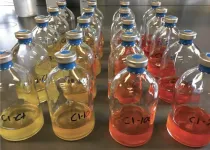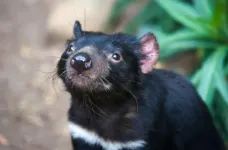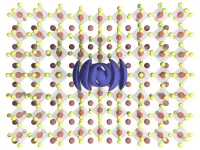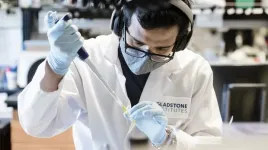(Press-News.org) PITTSBURGH, May 26, 2021 - In a paper published today in Science Advances, researchers from the University of Pittsburgh School of Medicine showed that inhalable nanobodies targeting the spike protein of the SARS-CoV-2 coronavirus can prevent and treat severe COVID-19 in hamsters. This is the first time the nanobodies--which are similar to monoclonal antibodies but smaller in size, more stable and cheaper to produce--were tested for inhalation treatment against coronavirus infections in a pre-clinical model.
The scientists showed that low doses of an aerosolized nanobody named Pittsburgh inhalable Nanobody-21 (PiN-21) protected hamsters from the dramatic weight loss typically associated with severe SARS-CoV-2 infection and reduced the number of infectious virus particles in the animals' nasal cavities, throats and lungs by a million-fold, compared to placebo treatment with a nanobody that doesn't neutralize the virus.
"By using an inhalation therapy that can be directly administered to the infection site--the respiratory tract and lungs--we can make treatments more efficient," said co-senior author Yi Shi, Ph.D., assistant professor of cell biology at Pitt. "We are very excited and encouraged by our data suggesting that PiN-21 can be highly protective against severe disease and can potentially prevent human-to-human viral transmission."
Previously, Shi and colleagues discovered a large repertoire of over 8,000 high-affinity SARS-CoV-2 nanobodies. From this repertoire, the scientists selected an ultrapotent nanobody (Nb21) and bioengineered it into a trimeric form to further maximize its antiviral activity. The resulting PiN-21 is by far the most potent antiviral nanobody that has been identified, according to the researchers' review of published studies.
The experiments showed that PiN-21 was protective when administered intranasally at the time of infection. Hamsters in the PiN-21 treatment group did not lose any body weight, unlike the placebo-treated animals who lost up to 16% of their initial body weight after a week of infection. For the average adult human, the rate of the weight loss would correspond to shedding roughly 20 pounds in a week.
Even more impressively, inhalation of aerosolized nanobodies at an ultra-low dose reduced the number of infectious virus particles in the lung tissue by 6-logs (or a million-fold). Animals who received aerosolized PiN-21 nanobodies had milder changes in the lung structure and a lower degree of inflammation than those who received the placebo.
To deliver therapeutics via aerosolization, the scientists had to overcome several technical challenges--small particle aerosols have to reach deep into the lung, and treatment particles need to be small enough so that they don't clump together and strong enough to withstand the extreme pressure required to suspend them in the air. PiN-21 nanobodies, which are approximately four times smaller than typical monoclonal antibodies with exceptionally high stability, are perfectly suited for the task. They also are much cheaper to produce and can be generated rapidly to swiftly adapt to the shape-shifting virus.
"COVID-19 is now a preeminent disease of the 21st century," said co-author Doug Reed, Ph.D., associate professor of immunology at Pitt. "Delivering the treatment directly to the lungs can make a big difference for our ability to treat it."
Researchers point out that the nanobodies and vaccines are complementary and do not compete with one another. Vaccines remain the best tool to stop the virus from spreading from person to person, but nanobodies will be useful to treat people who already are sick and those who can't get vaccinated for other medical reasons.
Promising early preclinical data, combined with the researchers' extensive knowledge about rapidly identifying drug-quality nanobodies, suggest that this approach can provide a convenient and cost-effective therapeutic option to control the coronavirus pandemic.
"This work is the result of experts in nanobody production, infectious disease and aerobiology working closely together. At the University of Pittsburgh Center for Vaccine Research, we don't just talk about ideas, we actually make them come to life," said co-senior author Paul Duprex, Ph.D., the center's director.
INFORMATION:
Other authors on the manuscript include Sham Nambulli, Ph.D., Natasha Tilston-Lunel, Ph.D., Linda J. Rennick, Ph.D., William Klimstra, Ph.D., all of the Pitt Center for Vaccine Research; Yufei Xiang, M.S., of Pitt's Department of Cell Biology; Zhe Sang, M.S., of Pittsburgh-Carnegie Mellon University Program in Computational Biology; and Nicholas Crossland, Ph.D., of Boston University.
This work was supported by the National Institutes of Health (grant #1R35GM137905-01), a University of Pittsburgh Clinical and Translational Science Institute pilot grant, the University of Pittsburgh, the Pitt Center for Vaccine Research, the Commonwealth of Pennsylvania Department of Community and Economic Development, the Richard King Mellon Foundation and the Henry L. Hillman Foundation.
Shi and Xiang are inventors on a pending patent related to this work filed by University of Pittsburgh (no. 63067567, filed on Aug. 28, 2020).
To read this release online or share it, visit https://www.upmc.com/media/news/052621-shi-duprex-pin21 [when embargo lifts].
About the University of Pittsburgh School of Medicine
As one of the nation's leading academic centers for biomedical research, the University of Pittsburgh School of Medicine integrates advanced technology with basic science across a broad range of disciplines in a continuous quest to harness the power of new knowledge and improve the human condition. Driven mainly by the School of Medicine and its affiliates, Pitt has ranked among the top 10 recipients of funding from the National Institutes of Health since 1998. In rankings recently released by the National Science Foundation, Pitt ranked fifth among all American universities in total federal science and engineering research and development support.
Likewise, the School of Medicine is equally committed to advancing the quality and strength of its medical and graduate education programs, for which it is recognized as an innovative leader, and to training highly skilled, compassionate clinicians and creative scientists well-equipped to engage in world-class research. The School of Medicine is the academic partner of UPMC, which has collaborated with the University to raise the standard of medical excellence in Pittsburgh and to position health care as a driving force behind the region's economy. For more information about the School of Medicine, see http://www.medschool.pitt.edu.
http://www.upmc.com/media
An inhalable nanobody-based treatment may effectively prevent and treat SARS-CoV-2 infections when administered at ultra-low doses, according to a new study in Syrian hamsters. This novel therapy, Pittsburgh inhalable Nanobody 21 (PiN-21), could provide an affordable, needle-free alternative to monoclonal antibodies for treating early infections. Sham Nambulli and colleagues recently developed PiN-21, which uses single-domain antibody fragments that are cheaper to produce than monoclonal antibodies. However, until this study, the efficacy of PiN-21 had not been reported in living organisms. To advance the development of this treatment, Nambulli et al. administered a 0.6 milligram per kilogram ...
Piscine orthoreovirus (PRV) - which is associated with kidney and liver damage in Chinook salmon - is continually being transmitted between open-net salmon farms and wild juvenile Chinook salmon in British Columbia waters, according to a new genomics analysis published today in Science Advances.
The collaborative study from the University of British Columbia (UBC) and the Strategic Salmon Health Initiative (SSHI) -- a partnership between Fisheries and Oceans Canada (DFO), Genome BC and the Pacific Salmon Foundation -- traces the origins of PRV to Atlantic salmon farms in Norway and finds that the virus is now almost ubiquitous in salmon farms in B.C.
It also shows that wild Chinook salmon are more likely to be infected with ...
Jodi Karnell and colleagues have developed a monoclonal antibody, VIB7734, that reduces symptom severity in people with cutaneous lupus by targeting and depleting plasmacytoid dendritic cells (pDC) in blood and skin. In two phase I clinical trials involving a total of 67 people with autoimmune diseases such as lupus, treatment with VIB7734 was as safe as a placebo and significantly reduced pDC frequencies, the researchers found. The antibody also reduced the activity of a group of key immune proteins called type 1 interferons in skin. Both pDCs and type 1 interferons are suspected ...
In the human gut, good bacteria make great neighbors.
A new Northwestern University study found that specific types of gut bacteria can protect other good bacteria from cancer treatments -- mitigating harmful, drug-induced changes to the gut microbiome. By metabolizing chemotherapy drugs, the protective bacteria could temper short- and long-term side effects of treatment.
Eventually, the research could potentially lead to new dietary supplements, probiotics or engineered therapeutics to help boost cancer patients' gut health. Because chemotherapy-related microbiome changes in children are ...
MOSCOW, Idaho -- May 26, 2021 -- University of Idaho researchers partnered with other scientists from the United States and Australia to study the evolution of Tasmanian devils in response to a unique transmissible cancer.
The team found that historic and ongoing evolution are widespread across the devils' genome, but there is little overlap of genes between those two timescales. These findings, published in Proceedings of the Royal Society B, suggest that if transmissible cancers occurred historically in devils, they imposed natural selection on different sets of genes.
Tasmanian devils suffer from a transmissible cancer called devil facial tumor disease (DFTD). Unlike typical cancers, tumor cells from transmissible cancers are directly transferred from one individual ...
Children of Latinx immigrants who take on adult responsibilities exhibit higher levels of political activity compared with those who do not, according to University of Georgia researcher Roberto Carlos.
Immigrant communities often display low levels of political engagement, but a new study by Carlos indicates that when children of Latinx immigrants take on adult roles because of parents' long work hours, immigrant status or language deficiencies, they develop noncognitive skills associated with higher rates of political participation.
"There is thriving in spaces that we wouldn't necessarily expect because of the hardship related ...
"If you can't measure it, you can't improve it". This concept is also true within the context of climate policy, where the achievement of the objectives of the United Nations Framework Convention on Climate Change (UNFCCC) is dependent on the ability of the international community to accurately measure greenhouse gas (GHG) emission trends and, consequently, to alter these trends.
Greenhouse gas (GHG) emission inventories represent the link between national and international political actions on climate change, and climate and environmental sciences. Research communities and inventory agencies have approached the problem of climate ...
Researchers at McGill University have gained new insight into the workings of perovskites, a semiconductor material that shows great promise for making high-efficiency, low-cost solar cells and a range of other optical and electronic devices.
Perovskites have drawn attention over the past decade because of their ability to act as semiconductors even when there are defects in the material's crystal structure. This makes perovskites special because getting most other semiconductors to work well requires stringent and costly manufacturing techniques to produce crystals that are as defect-free ...
SAN FRANCISCO, CA--May 26, 2021--In January 2021, reports of a new coronavirus variant that had emerged in California raised many concerns. Preliminary data suggested that it is more transmissible than the unmutated strains of SARS-CoV-2 (the virus that causes COVID-19) from which it evolved.
Now, a multifaceted collaboration between researchers at UC San Francisco, Gladstone Institutes, and other organizations across California provides a comprehensive portrait of the variant--including its interaction with the immune system and its potential to spread.
"Our ...
Even though people stayed in touch during the pandemic's stay-at-home orders and social distancing, it was easy to feel out of touch with loved ones.
Technology and the internet have expanded the way humans communicate and added much to that communication -- think emojis, GIFs and memes. But they can still fall short of being physically with someone.
"Our social cues are limited online," said Fannie Liu, a research scientist at Snap Inc who earned her Ph.D. from the Human-Computer Interaction Institute in Carnegie Mellon University's School of Computer Science. "We're exploring a new way to support digital connection through a deeper and more internal cue."
Liu was part of a team from CMU, Snap and the University ...





